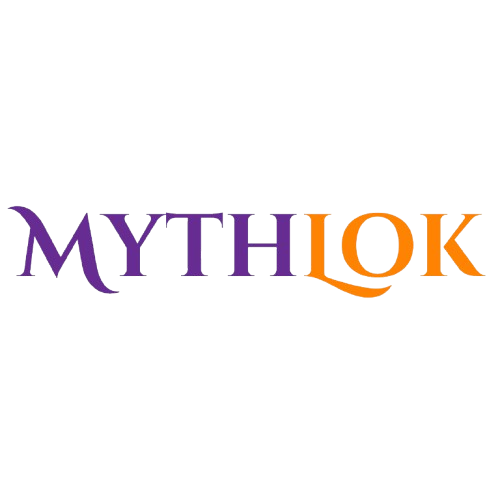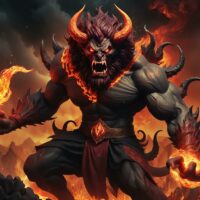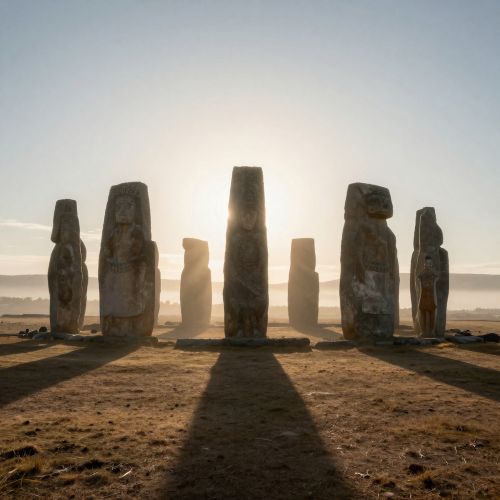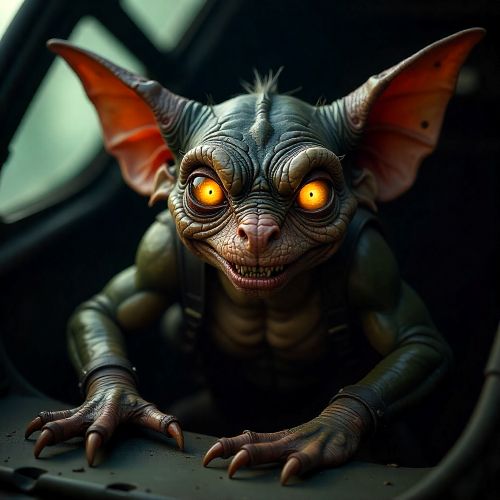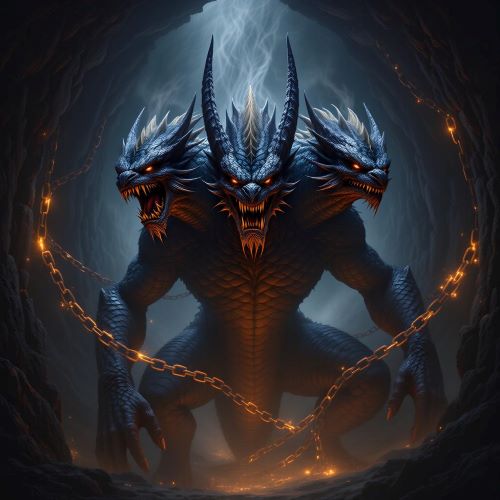Aeshma : The Embodiment of Wrath
Listen
At a glance
| Description | |
|---|---|
| Origin | Iranian Mythology |
| Classification | Hybrids |
| Family Members | N/A |
| Region | Iran |
| Associated With | Chaos, Wrath, Fury |
Aeshma
Introduction
Aeshma stands as a force of unrelenting fury and chaos in Zoroastrian mythology. His very name, rooted in the Avestan word for “wrath,” captures his essence—rage, violence, and the drive to disrupt order. As one of the most formidable daevas, he thrives on conflict, working to unravel the harmony upheld by Ahura Mazda. Aeshma’s influence seeps into war, sacrifice, and intoxication, distorting sacred rituals and sowing discord wherever he moves. His greatest adversary, Sraosha, embodies discipline and devotion, standing as the last line of defense against Aeshma’s relentless havoc. Even beyond Zoroastrian belief, his shadow lingers in later traditions, surfacing in the Talmud and the Book of Tobit under different names, yet carrying the same essence of destruction.
Physical Traits
Aeshma looms as a figure of unrelenting fury, his presence a swirling storm of chaos and rage. Fiery eyes burn with malice, sharp teeth gleam in the shadows, and clawed hands curl, eager to tear through harmony and order. Some visions carve strange markings across his form, etching his essence into his very skin. Wings unfurl from his back, jagged and unnatural, while blackened hands grip the weight of destruction itself. Flames flicker around him, a reminder of his insatiable thirst for turmoil. In every form, in every vision, he stands as a force of raw, violent wrath—unstoppable, untamed, and forever at odds with the light.
Family
Aeshma stands among the daevas, bound not by blood but by allegiance to chaos and destruction. His existence coils around Angra Mainyu, the shadow that seeks to unravel creation, his will carried out as a relentless force of fury. Az, the insatiable demon of greed, moves beside him, their purposes entwined in a ceaseless march against order. Power is not inherited but taken, and Aeshma wields his command like a weapon, striking at the souls that dare to cross into judgment. No gentle ties of kinship define him—only the dark current of rage that pulls him ever forward, ever against the light.
Other names
Aeshma’s name echoes through a variety of forms, each capturing a facet of his dark power. In Middle Persian, he’s known as Eshm or Kheshm, while other variants like Aesman, Xesm, Hēšm, and Hāšem appear in different texts. His titles speak to his nature—”of the bloody mace,” a reflection of his brutal force, or “ill-fated” and “malignant,” highlighting the destruction he brings. His connection to falsehood is also clear, casting a shadow of deceit wherever he treads. His reach extends beyond Zoroastrianism, appearing in Jewish lore as Asmodeus, the demon of lust and fury, and influencing languages like Georgian, where “Eshmaki” denotes the devil, a reminder of Aeshma’s enduring presence across cultures.
Powers and Abilities
Aeshma moves like a storm of fury, his presence igniting chaos wherever he treads. Wrath coils through his being, a force that twists minds and bends hearts toward violence. Conflict follows in his wake, a whispered suggestion turning into a raging battle, a flicker of anger swelling into unrelenting bloodshed. Even demons are not immune to his influence—his power stirs strife among his own kind, setting them against each other in blind fury. His blows crack the earth, his strength unyielding, his body resistant to poison and lightning alike. The skies offer no refuge; he soars through them with ease, a shadow of destruction blotting out the light. But no force is absolute—prayers, spoken with devotion, unravel his grip, pushing back against the tide of chaos he seeks to unleash.
Modern Day Influence
Aeshma’s presence lingers in modern culture, his essence woven into stories, symbols, and mythologies that explore the raw intensity of wrath. He emerges in literature and art as a manifestation of unchecked aggression, a force that fuels destruction but also the relentless drive for transformation. Shadows of his legend appear in demonology, evolving into Asmodeus in Jewish and Christian traditions, solidifying his place as an eternal adversary of order. In films, books, and games, echoes of his fury shape characters and conflicts, a reminder of the ever-present struggle between chaos and control. Even in the digital age, his name surfaces—on wikis, in lore, as a creature conjured from the depths of myth. A force that refuses to fade, he stands as both a warning and a reflection of the fire that burns within.
Related Images
Source
Boyce, Mary. Zoroastrians: Their Religious Beliefs and Practices. Routledge, 2001.
“Aeshma.” Encyclopaedia Iranica. Available at Encyclopaedia Iranica.
“Aeshma – Wikipedia.” Available at Wikipedia.
Britannica, The Editors of Encyclopaedia. (2025, March 24). Aeshma.
World History Encyclopedia. (2020, January 16). Ancient Persian Gods, Heroes, and Creatures – The Complete List.
Zaehner, R. C. (1955), Zurvan. A Zoroastrian Dilemma, Oxford.
Dhalla, Maneckji N. (1938), History of Zoroastrianism, New York: OUP.
Eranshahr. (2024, May 24). Aeshma اَیَشمَه.
Frye, R. N. (1973), “Qumran and Iran,” Studies Dedicated to Morton Smith, ed. J. Neusner, Leiden.
Frequently Asked Questions
What is lorem Ipsum?
I am text block. Click edit button to change this text. Lorem ipsum dolor sit amet, consectetur adipiscing elit. Ut elit tellus, luctus nec ullamcorper mattis, pulvinar dapibus leo.
What is lorem Ipsum?
I am text block. Click edit button to change this text. Lorem ipsum dolor sit amet, consectetur adipiscing elit. Ut elit tellus, luctus nec ullamcorper mattis, pulvinar dapibus leo.
What is lorem Ipsum?
I am text block. Click edit button to change this text. Lorem ipsum dolor sit amet, consectetur adipiscing elit. Ut elit tellus, luctus nec ullamcorper mattis, pulvinar dapibus leo.
What is lorem Ipsum?
I am text block. Click edit button to change this text. Lorem ipsum dolor sit amet, consectetur adipiscing elit. Ut elit tellus, luctus nec ullamcorper mattis, pulvinar dapibus leo.
What is lorem Ipsum?
I am text block. Click edit button to change this text. Lorem ipsum dolor sit amet, consectetur adipiscing elit. Ut elit tellus, luctus nec ullamcorper mattis, pulvinar dapibus leo.

